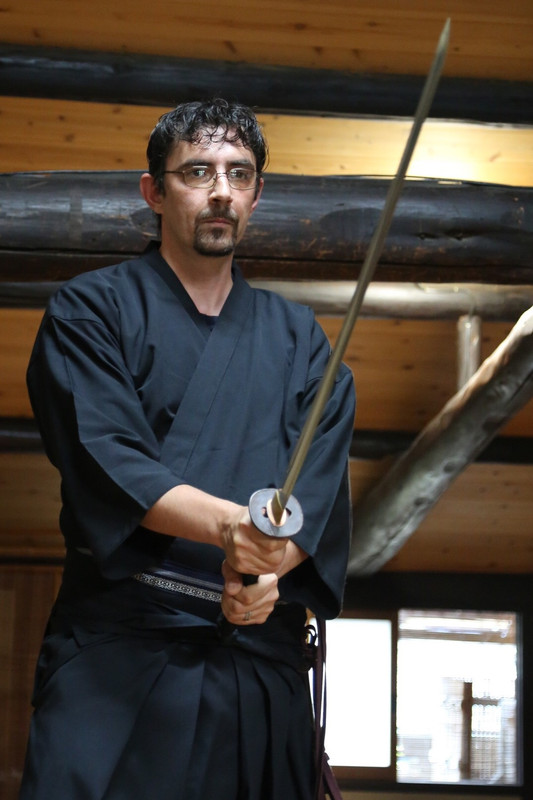Post by Verity on Aug 10, 2018 20:52:16 GMT
Introduction
It all began on a spring day in 1991. A young lad, having spent years looking at his father’s saber and watching He-Man on Saturday mornings as well as movies like Ladyhawk, Krull, Legend, Labrynth, Conan, The Dark Crystal, Excalibur and many many other movies of the golden “sword and sorcerer” age of cinema as well playing The Legend of Zelda, Final Fantasy, Ninja Gaiden, Ghosts ‘n Goblins and all sorts of sword-related Nintendo games, decided he needed his own REAL sword.
Pleading and pleading to his mom and dad to no avail finally yielded a determination in this young lad: He would own a real sword.
Finally, the boy proposed a plan to his parents. What if he earned the money himself to buy one? Would they then let him get it? After much deliberation, the parents agreed as long as the sword was unsharpened (it was a 12-year old boy, after all).
The parents were dubious, however, that the boy would be able to earn that sheer amount of money to be able to purchase a sword, given the youngling’s propensity to chase shiny things at a whim at the time and had never before been able to muster hundreds of dollars toward any purchase.
But the boy was determined. Setting out to the neighbors pleading for any kind of work that would yield the precious coin to acquire a sword, he mowed lawns, raked yards, weeded gardens, hacked at brambles, picked berries and all sorts of other jobs until one day, towards the end of the summer of 1991, the boy had enough to consider a first sword purchase.
Now, what sword to acquire? Going to his stack of Museum Replicas and Atlanta Cutlery catalogues, the boy began pouring over the options that lay in front of him....
A scimitar? The “Sword of Chaos”? A simple and sturdy Norman sword? What blade would this young lad spend his dollars on?
Paging through the catalogues, his heart leapt when he came across a beautifully tapered and strongly pointed blade, with a blue suede wrapped handle with wire filigree and a rampant unicorn on the pommel.
His whimsy tickled and thinking immediately of one of his beloved films, “The Last Unicorn,” the boy’s decision had been made.
Lady Amalthea would be so proud.
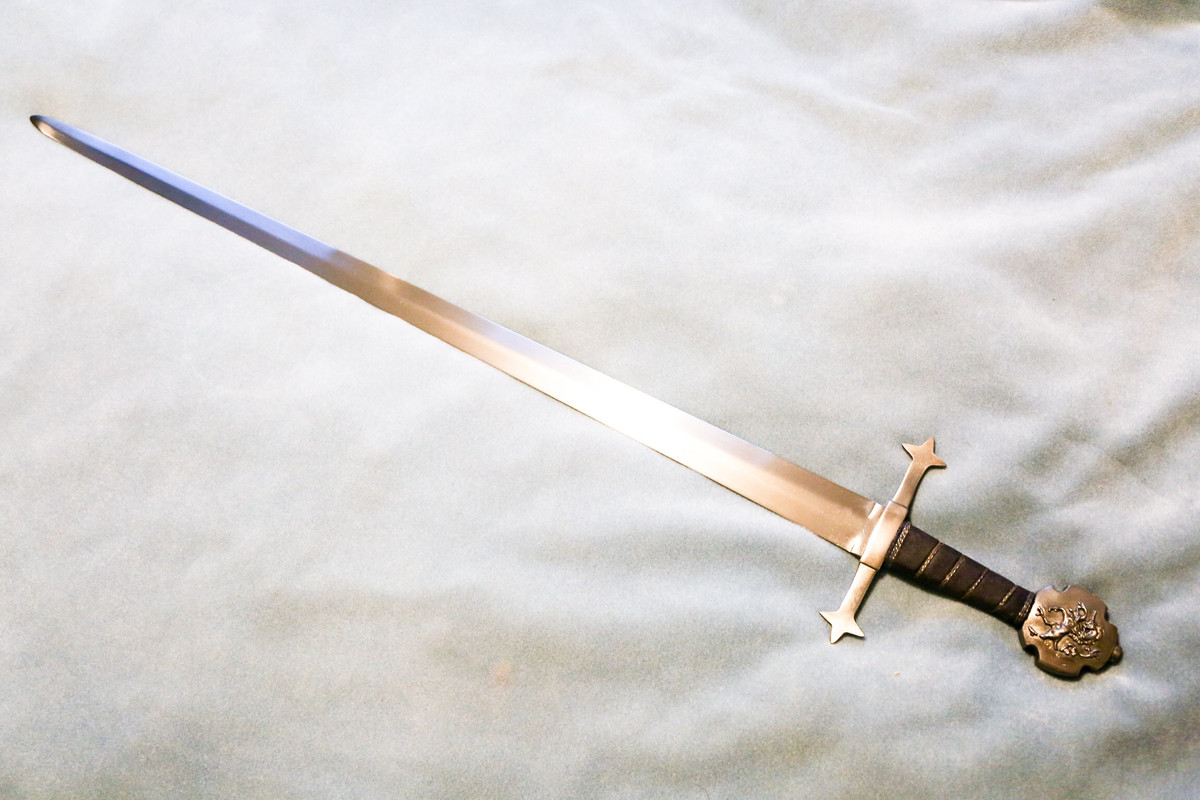
Historical Overview
Going back nearly 30 years, in the days before the internet and social media, before we had SBG and the widespread options for sword purchasing was limited to few production companies and antique collection societies, MRL was in its golden age and reigned as one of the top outlets for purchasing swords. At the time their main vendors being offered were Del Tin, Windlass and in some cases Marto. (Windlass is still a clear favorite of theirs to this day).
This Del Tin model, under MRL’s fantasy section and called simply the “Unicorn Sword” was made from CK55 Krupp (remember that stuff? A particular 1055-type of blend by Krupp) steel and featuring a sort of narrow XV type blade.
While a work of fantasy, I believe the XV type of blade is the closest historical approximate category for this sword.
The Type XV sword saw its rise during the course of the second half of the 13th and into the 14th century when a blade that could find gaps in the rising plate armor was necessary. Swords started evolving away from the cutting-focused and wide blades and formed into finely pointed blades focused on thrusting with strongly reinforced diamond cross sections. Some width was kept for cutting and beginning the era of the thrust-oriented type blades that the XV represents.
The XV type of sword lasted for more than two centuries. More on the type XV can be read here and here.
Full Disclosure
Nothing aside from sentimentality over this being my very first sword I’ve ever owned will cloud my review.
I have no affiliation with Museum Replicas, Ltd. or Del Tin.
There is no cutting observations because, to this day, I’ve never sharpened this sword. I may do so at some point and will provide cutting observations at that point but currently do not have any cutting observations.
Final disclosure is that, to my knowledge, there is nowhere you can obtain one of these aside from a secondhand owner. This model has been discontinued for decades.
Initial Impressions
Well, now this was almost 30 years ago so there is little hope of giving my true and completely accurate first impressions, but I remember thinking how sturdy the sword felt. It was heavy (for a 12-year old), and the blade had more flex than I’d had expected. Now note, the ONLY sword I had ever held until this point was my father’s Prussian saber, whose blade is VERY stiff. So holding this new sword for the first time the blade flexing like it did surprised me. Now, many years later, I remark at actually how stiff this blade is compared to almost all of my other double-edged swords.
The suede was beautifully wrapped and the wire twist accents bright (now, the suede has worn down significantly and the wire has patina’d substantially but in its day this grip was STUNNING).
The guard was cool looking, but in retrospect is a TERRIBLE design, as I quickly learned when swinging it, the bottom points of the star-like protrusions on the ends jabbed me in the wrist. It’s not particularly comfortable. 😂
It swings... like a sword. By today’s standards it’s not amazing but it’s not a crowbar either. It’s a decent albeit-on-the-tip-heavy side of the sword’s type.
At the time in a 12-year old’s mind? I was in awe.
Statistics
Components
Assembly / Construction
Construction is pretty consistent with production swords of this time period from MRL catalogue swords from the likes of Windlass and Del Tin. Keyed pommels were rarely if ever seen and peens were almost never to be found. I’m sure custom smiths did this 30 years ago, but the production companies that MRL were dealing with had not yet evolved to adopt these techniques very often, especially not for a sub-$300 sword.
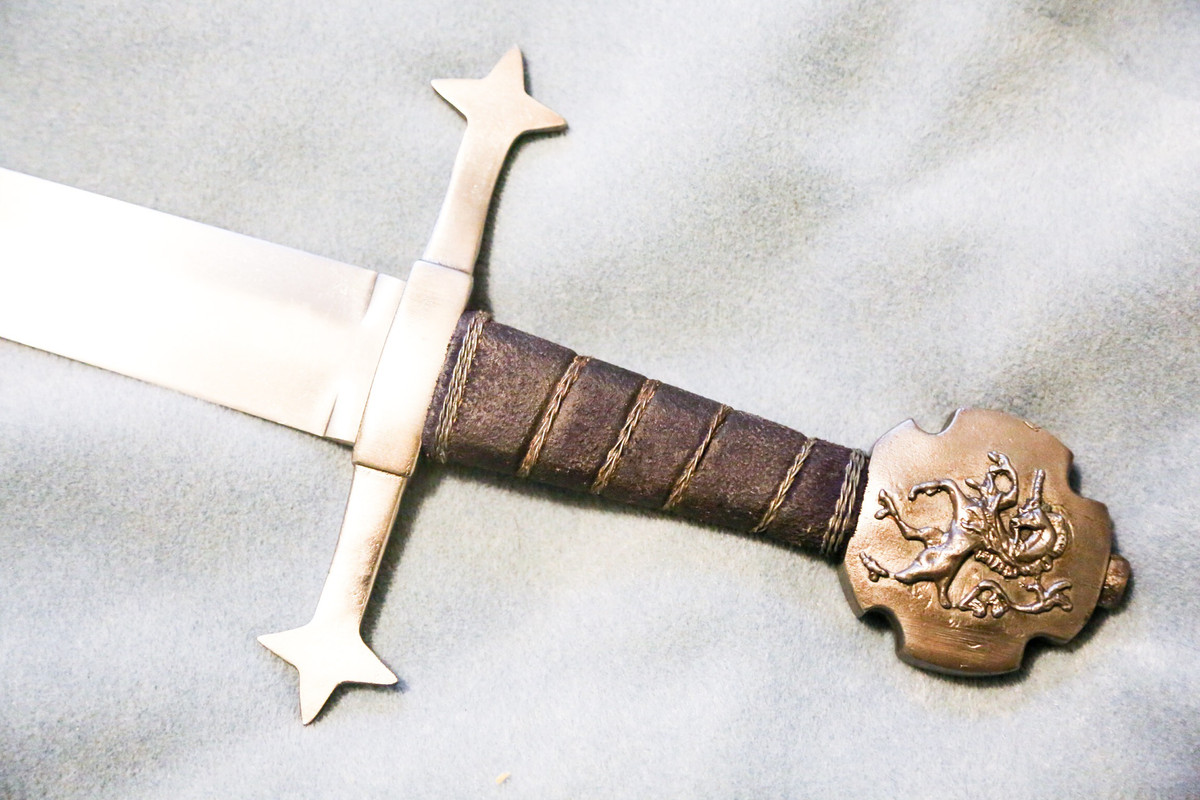
The guard is relatively well-fit to the blade with no play when everything is tightened down. The hilt is attached via a threaded tang and thick rod that the guard, grip and pommel all slide into and are then tightened down with a hex nut (e.g. “threaded compression”).
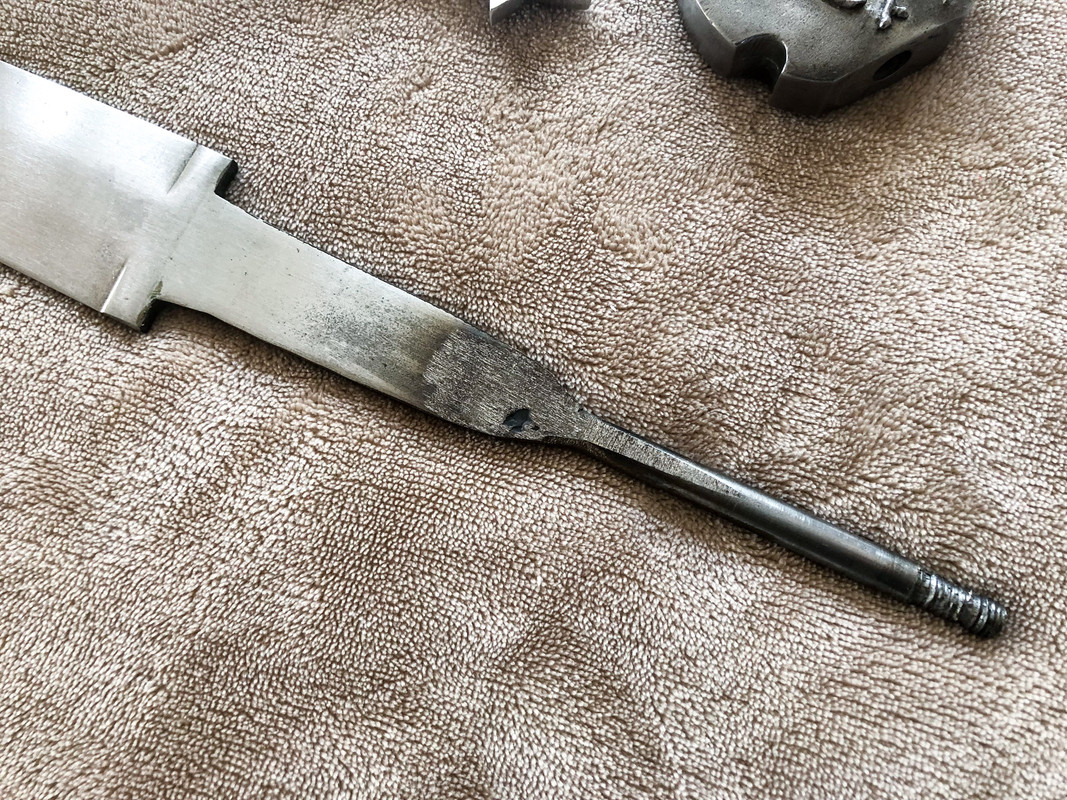
Clearly not ideal by today’s standards given the stress it places on the grip.
See here for an explanation as to why pommel constructions matter.
Certainly not a rat-tail tang, however, and the shoulders are relatively wide (not quite ideally rounded) with plenty of meat on the tang. The rod appears to be welded on and threaded but the welds appear solid and sturdy, albeit not the cleanest.
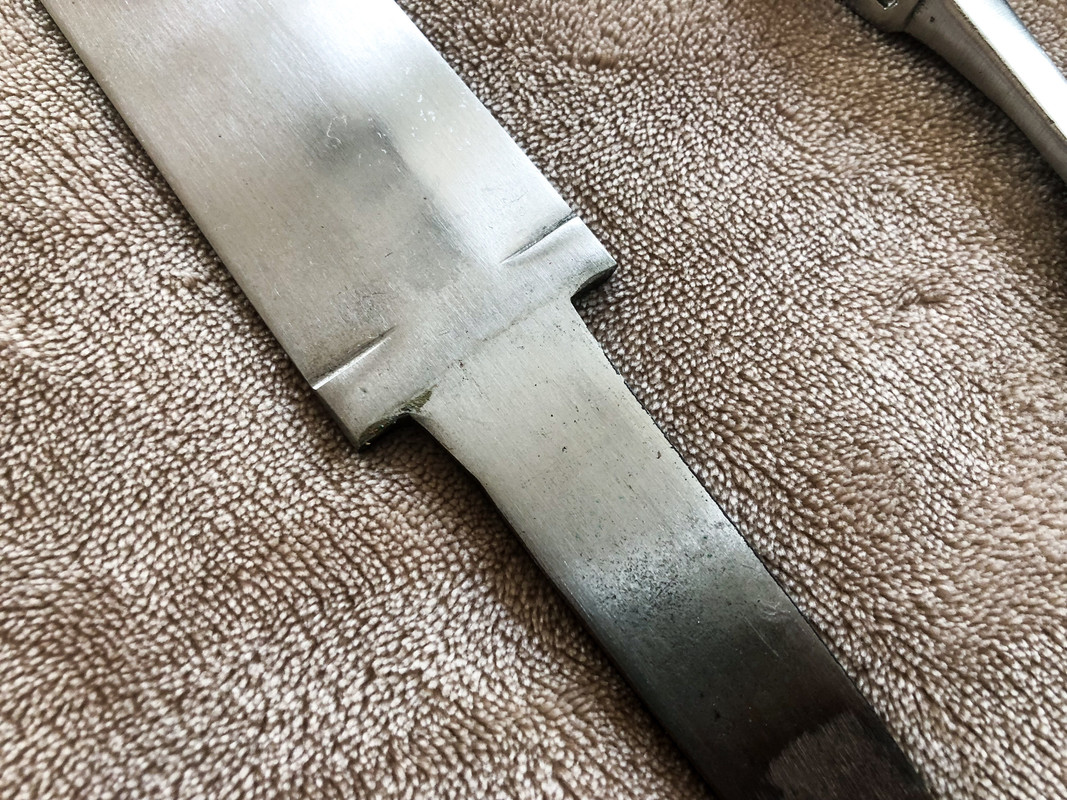
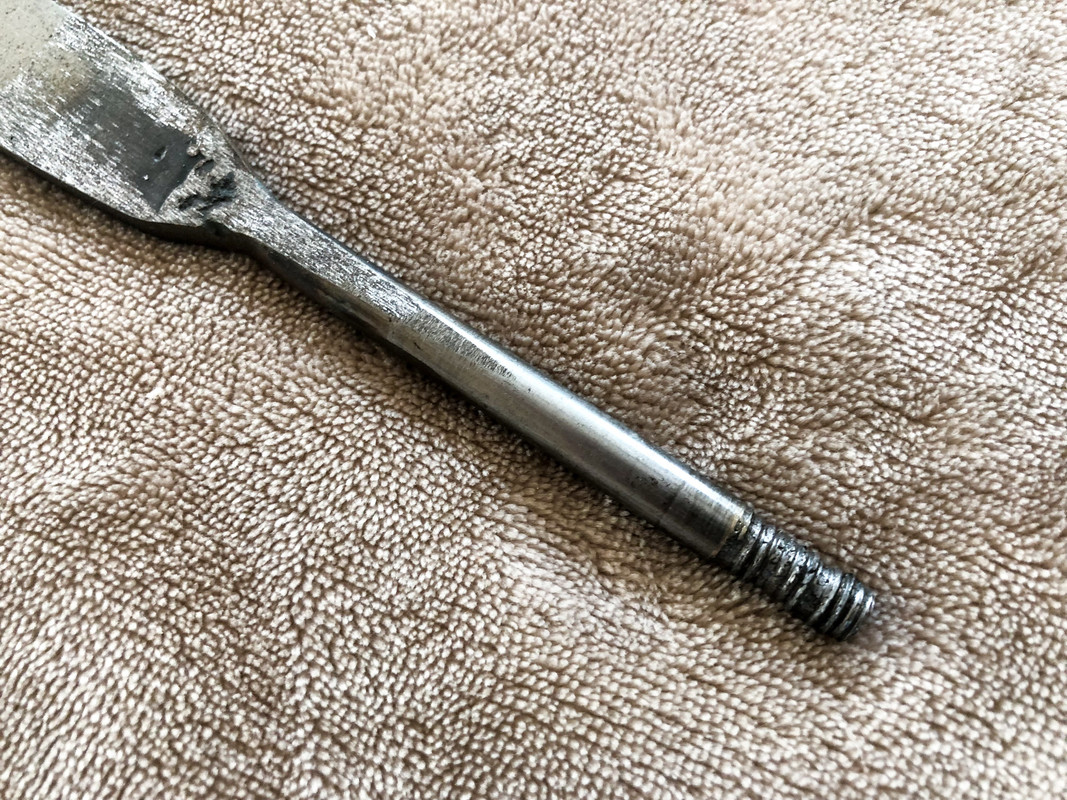
I suspect if the grip were shortened by maybe a centimeter the pommel could be keyed on the shallower side and the protruding end of the tang out of the back could be peened. Minor modifications could make this a much more structurally sound sword. Even if not peened you could do a hex nut recess in the pommel and still make the sword able to be disassembled. But not without shortening the grip some and having an indexed and keyed pommel.
The Blade
The blade, essentially what I would consider a variant of the Type XV. Is predominantly a flattened diamond cross-section with a clearly visible central ridge that goes all the way to the point. The first 3/8ths of the blade has a flattened hexagonal cross section that fades into the flattened diamond, however, so that does deviate from the standard XV designation.
Brushed finished steel (roughly similar to which you’d see on Atrim type blades). It is relatively clean and crisp but there is a couple areas of surface grind ripple where the bevels are not completely a smooth plane.

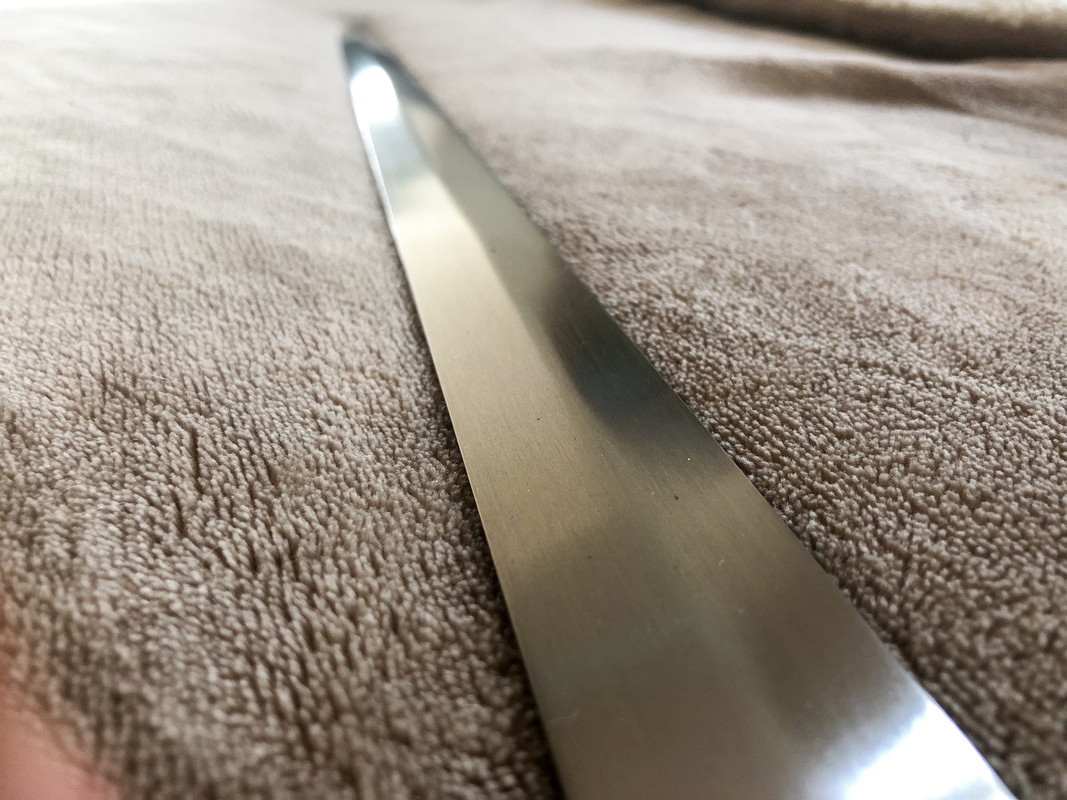
This is better than the Windlass swords of the same era that I possess however.
I’m not sure whether Del Tin had hand forged blades at this time period or whether they were stock removal, but this blade has a hand forged “feel” to it, if that makes any sense.
Given the blade is unsharpened it has a 1/16th or so blunt edge (maybe 1-1.5mm?). The edge has a distinct, flat plane for the first 6” or so and is more “rounded” from there to the tip.
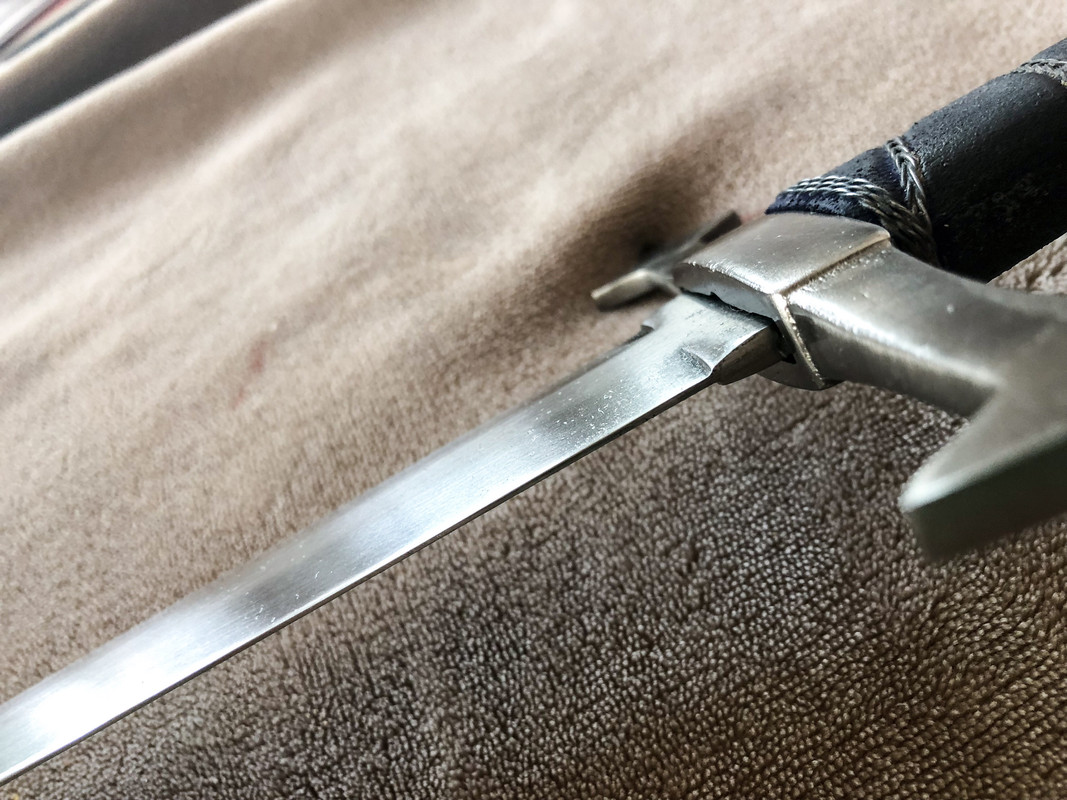
The blade has a nice even profile taper to the point which is not needle but more of a slightly rounded but very narrow point.
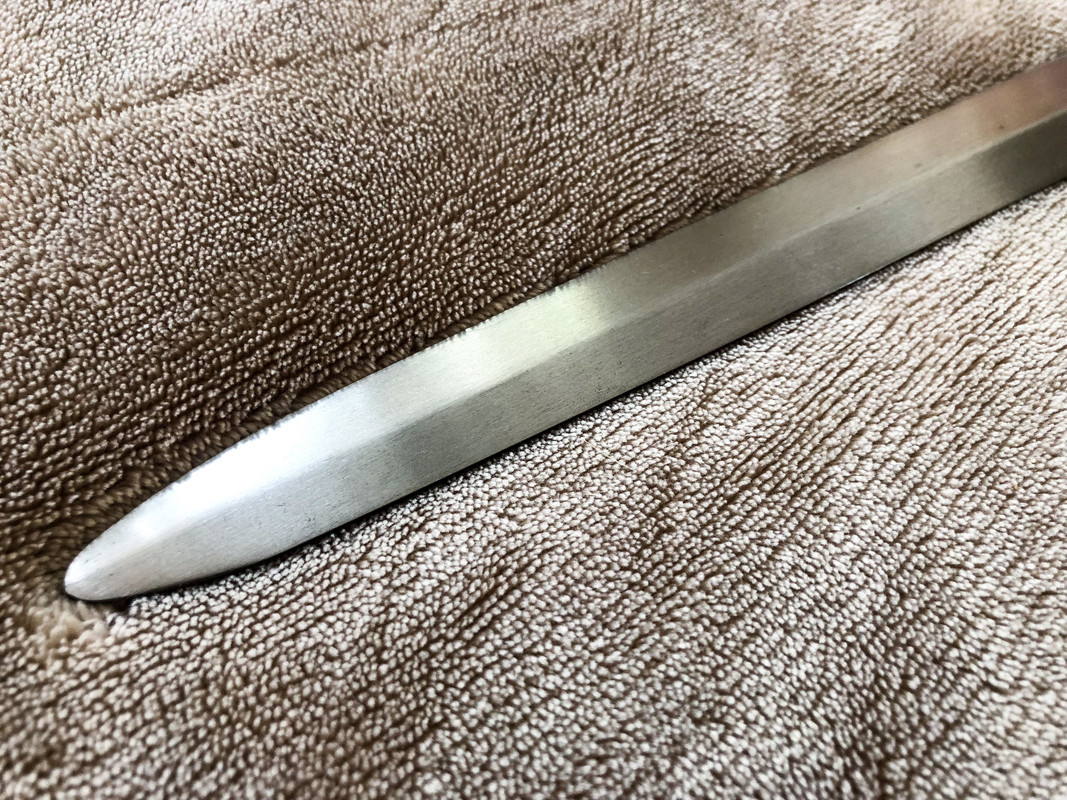
There is not much distal taper in the blade, literally a single millimeter over the entire length. This contributes greatly to the blade lacking a ton of liveliness and its somewhat tip-heavy feeling despite the sub-5” point of balance.
My biggest complaint about the blade itself though is the fact it has a super short ricasso where the base of the primary bevels terminate in a perpendicular direction to the edge like you’d see on a knife. I do NOT like this trait. I’d rather have seen the primary bevel taken all the way to the blade shoulders under the guard. If ever I got this sharpened, I’d seriously consider attempting to do this, but that would be a healthy amount of work.
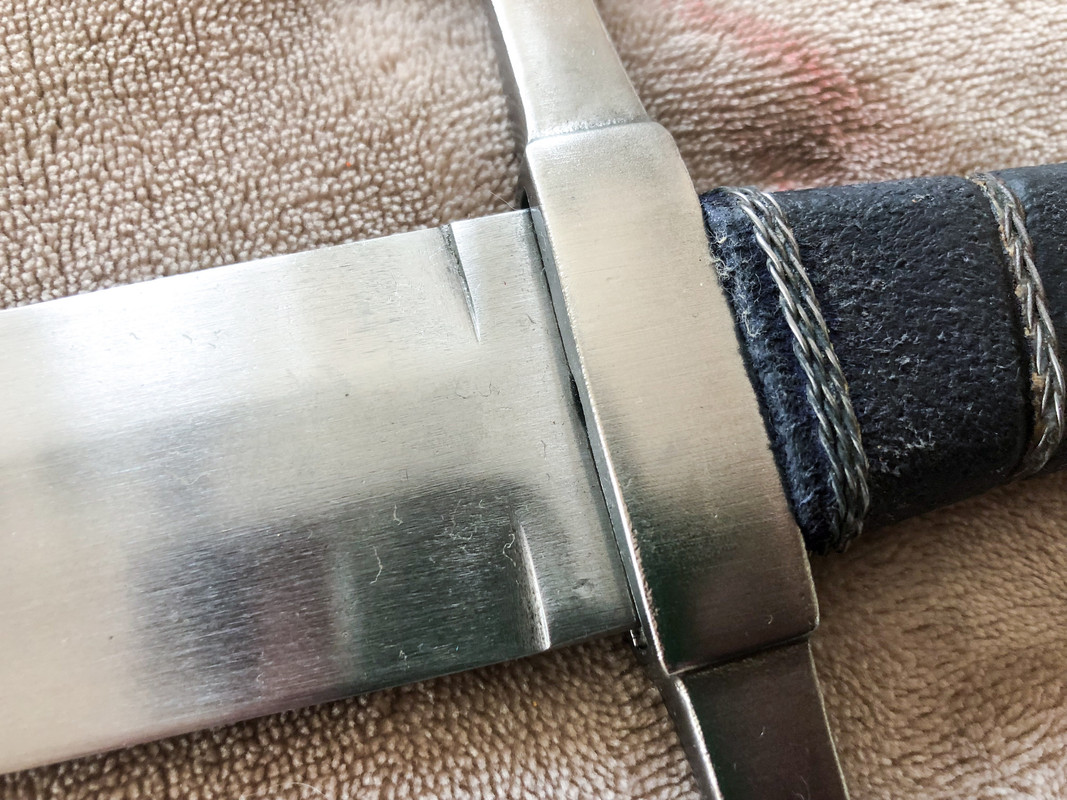
The blade is very stiff but still has a nice spring temper. I have bent this blade 30-degrees or more without any issue with it returning to true.
Distinct and recognizable vibration node harmonic points along the blade when held and struck, all of which are appropriate for this type of blade.
The Grip
The grip, now worn with age, was STUNNING when the sword was new. A beautiful and radiant royal blue soft suede wrapped around hardwood, and then finished off with twisted wire filigree.
It’s been worn down with years of holding, handling, and swinging, but originally this grip was simply beautiful. The ergonomics of the grip are simple but comfortable, with the wire gaps sitting nicely in the fingers to give the grip a solid and grippy feel.
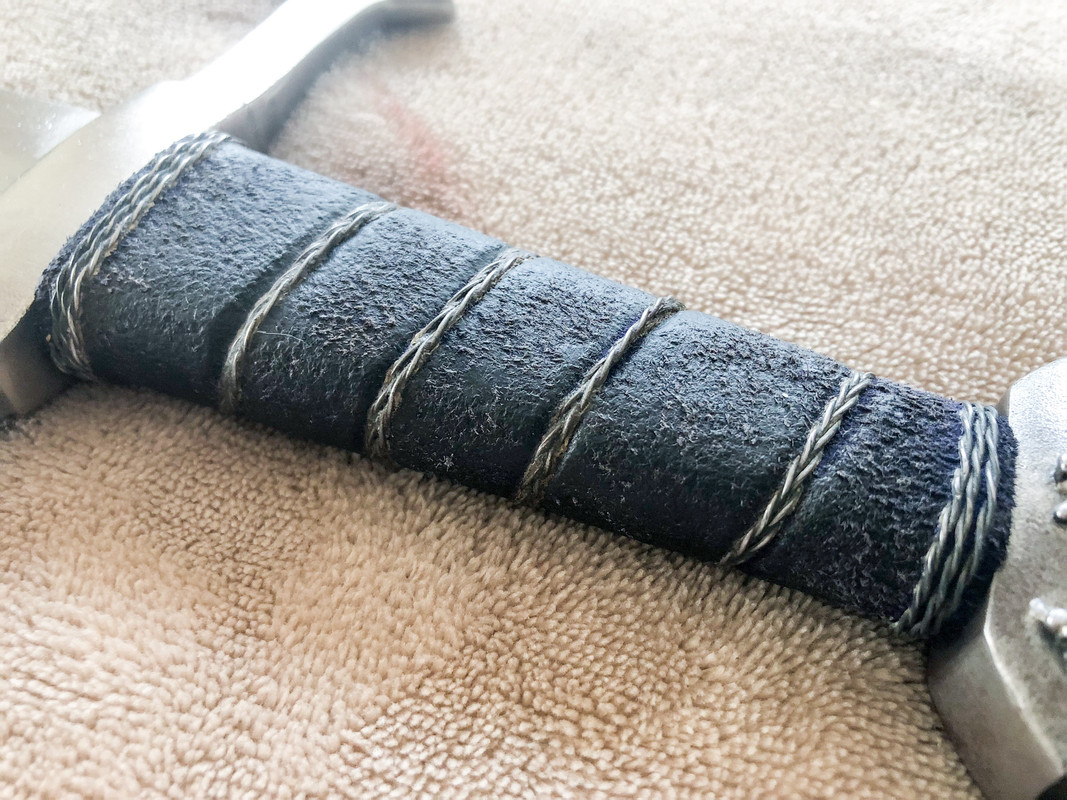
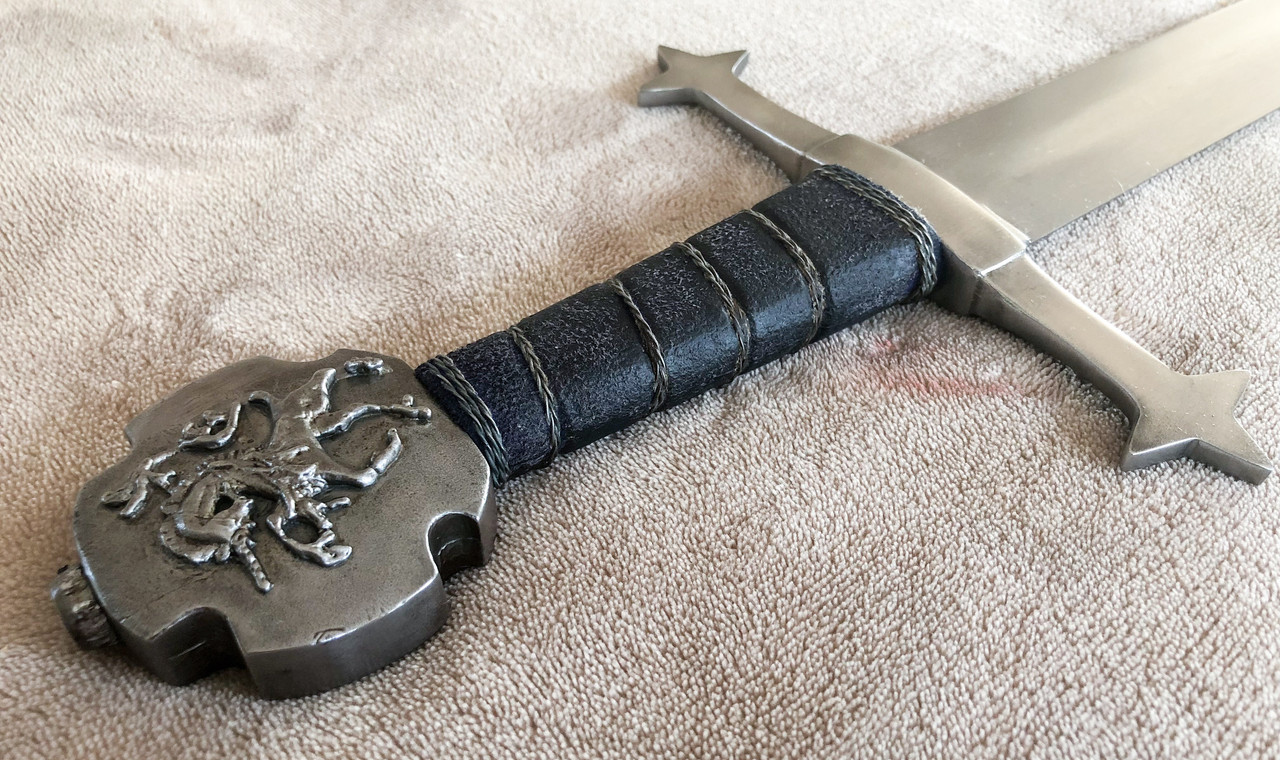
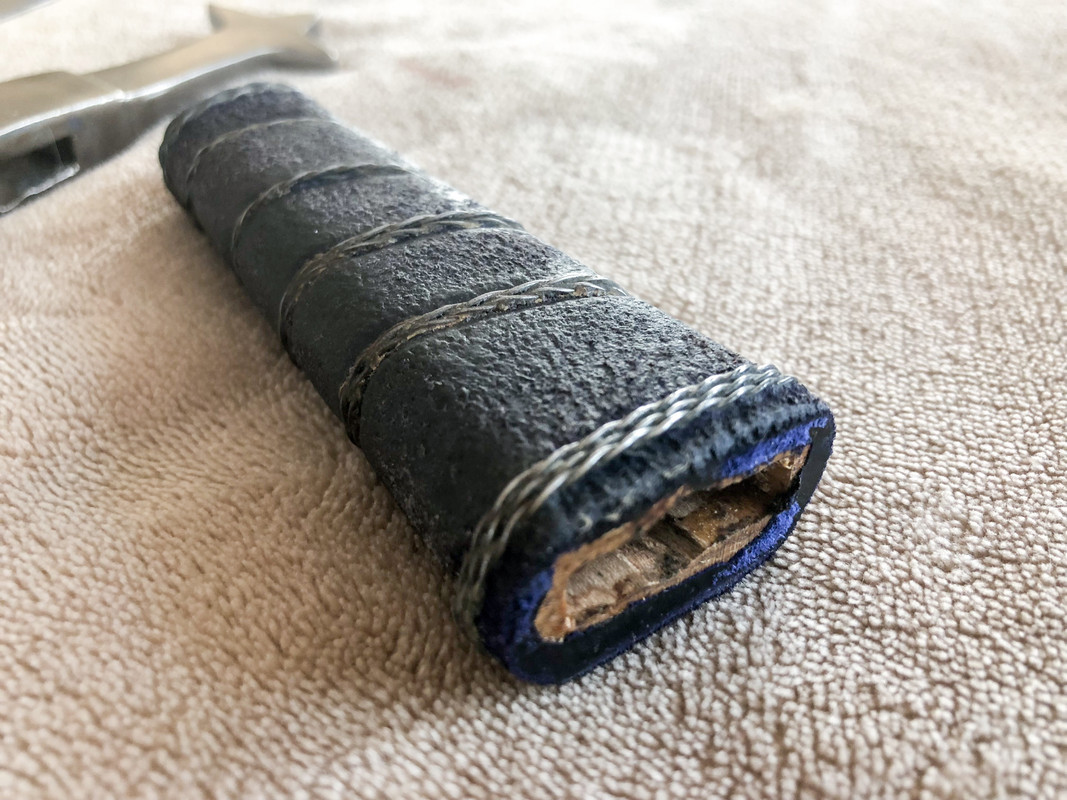
The Guard
Ok, this is where things get ugly. Where do I begin? First, the finish is not great. The lines are there but not super crisp. And the finish is kind of sloppy, probably just finished with a slack belt sander and no hand polishing.
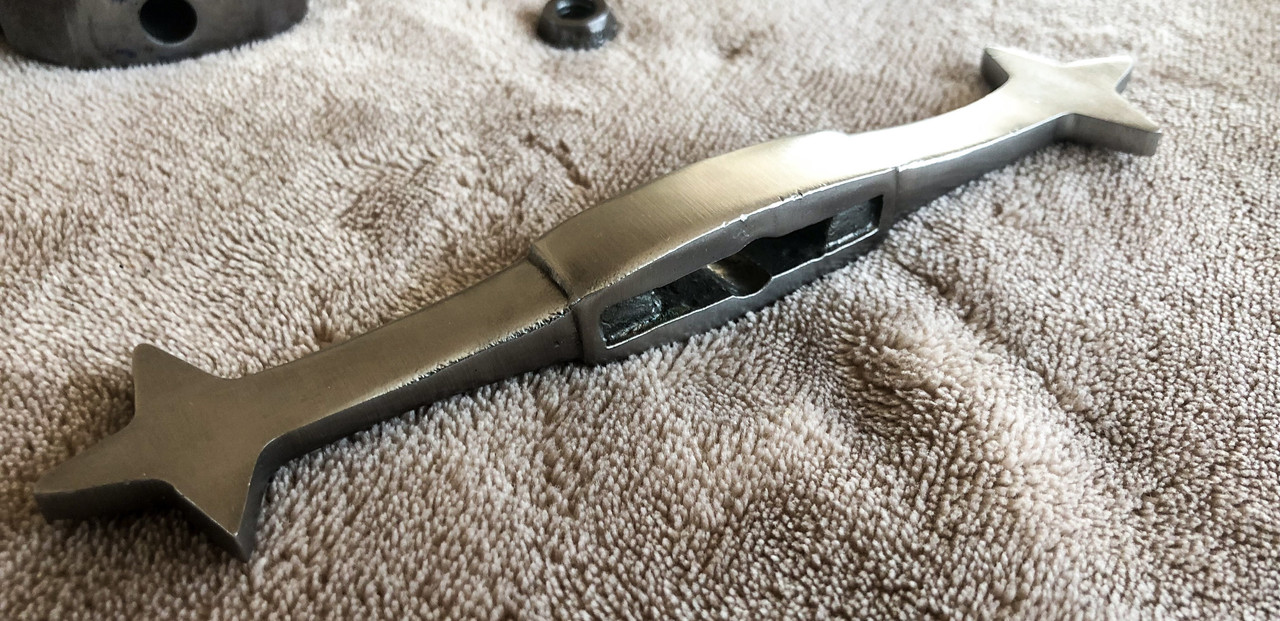
The fit to the blade is remarkably well done however with there being very little if any play on the tang of the sword.
Now let’s get to the design... wow... just wow. Whoever thought this guard was a good idea on a sword was out of their minds. I look back, knowing what I do now, and want to smack that 12-year old kid upside the head for not choosing a different first sword.
The design is AWFUL from a practical use perspective. It jabs the wrist or forearm when maneuvering this sword. I literally cannot do any serious forms with this sword without a glove on because it just hurts and is uncomfortable.
Forget about doing a moulinette with this sword. It’ll chew your forearm up. Bad.
I suspect the whole “fantasy” notion here was you could use the guard as a nice weapon to punch out with, and that is for sure! Those points are sharp! Heck they have more of an edge than the blade does given it’s not sharpened 😂
But yeah. Out of all the downsides of the sword, this one is the BIGGEST issue. Ewww...
But it does look cool, right? 🙄
The Pommel
Yeah yeah. It’s not keyed, like I said in the construction section. Yeah yeah, it’s cast from mild steel. But c’mon! UNICORNS!!
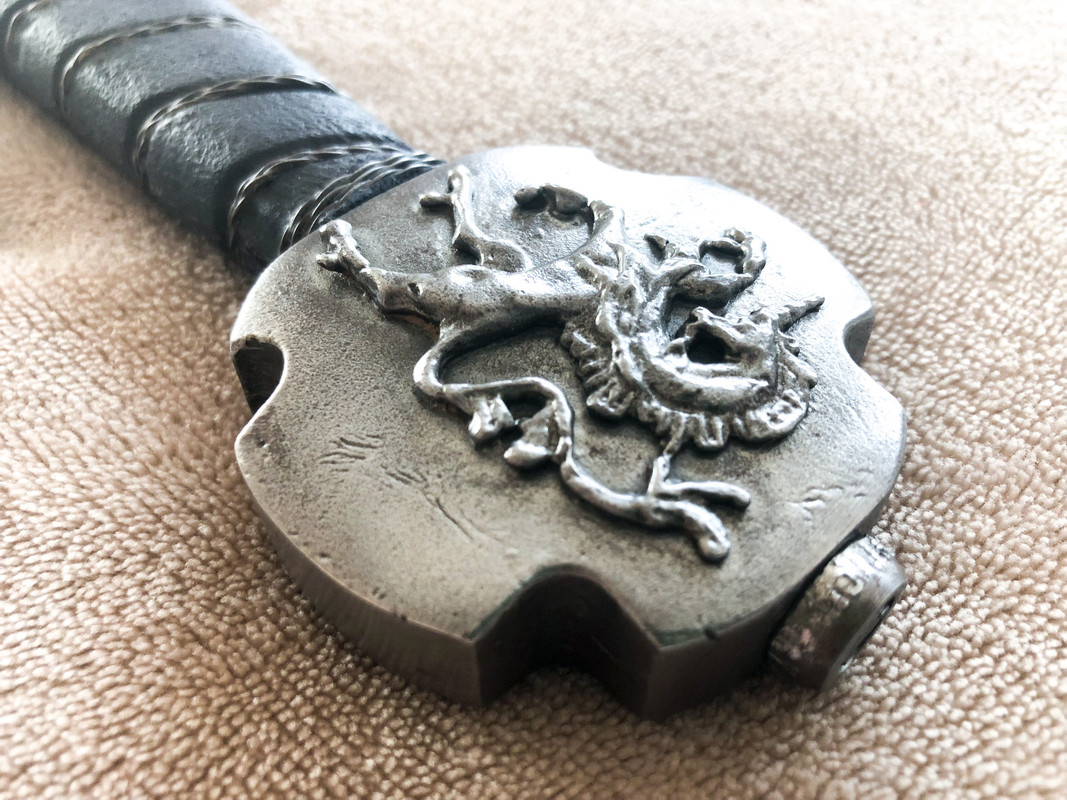
How many swords do you see with unicorn motif? Unicorns are cool, people.
So to be honest this was probably the main reason I originally bought this sword. If you had read the introduction section you know why. I loved “The Last Unicorn” and this sword reminds me of it every single time I look at it.
Or... if you rather, for those fans of the Forgotten Realms setting of novels, I imagine this is a blessed sword of the goddess Mielikki whose main sigil is that of a unicorn. Side note: Mielikki was also an actual historical Finnish goddess.
Ok ok. Back to the review observations...
Practically speaking the pommel is on the heavy side to balance out the blade which has little distal taper, and the cutouts in the perimeter are also a bit uncomfortable to the wielder, also contributing to the discomfort when swinging this sword around. It is not as large of a contributing factor as the guard though.
Un-keyed with no fancy peen. It’s a simple pommel (aside from the cool unicorns, that is).
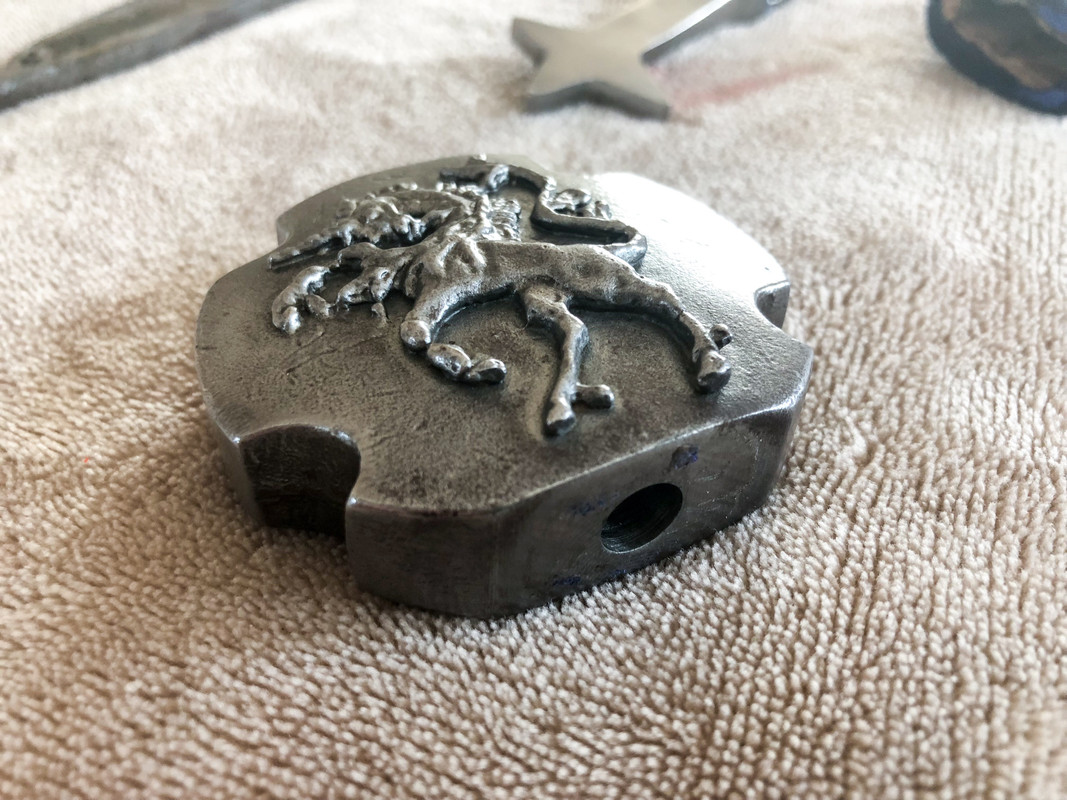
The Scabbard
Simple, black leather stitched scabbard. Not sure how MRL managed to milk people out of money on their early scabbards because these are really nothing special.
We have amazing scabbard makers out there that make wood core, leather wrapped scabbards so... way better ones out there. But let’s remember this was a sub-$300 sword and the scabbard option if I recall was $45. So... meh. It holds the blade.

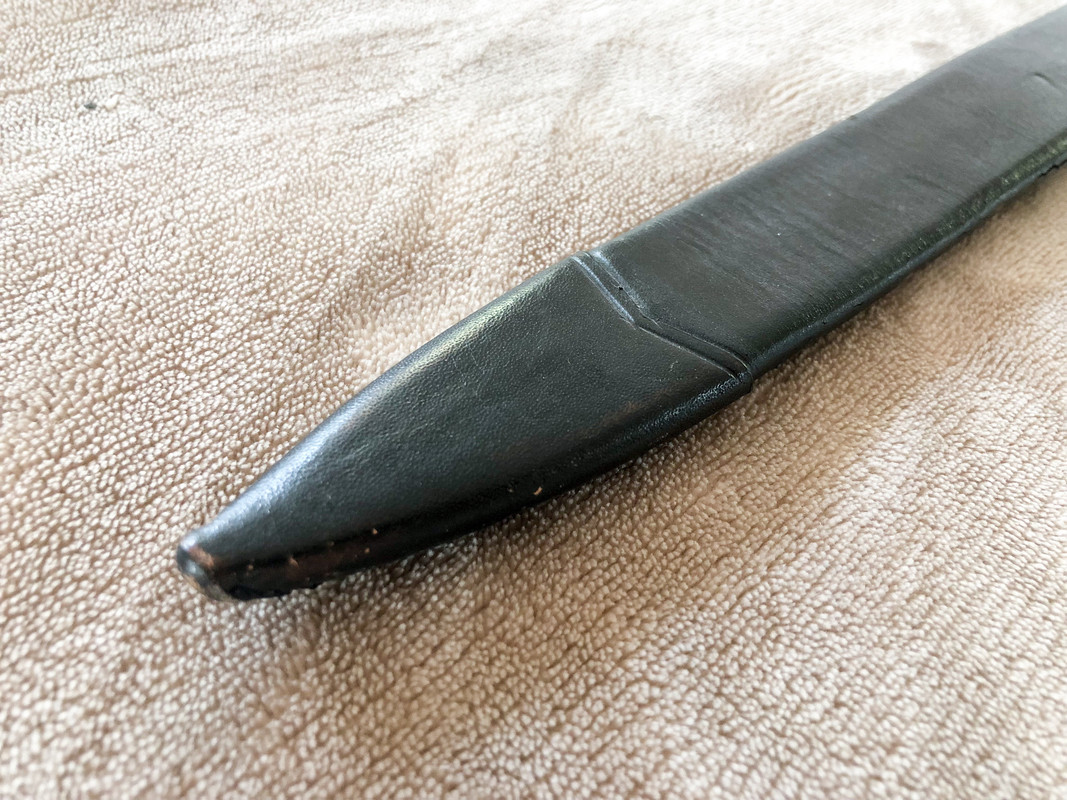

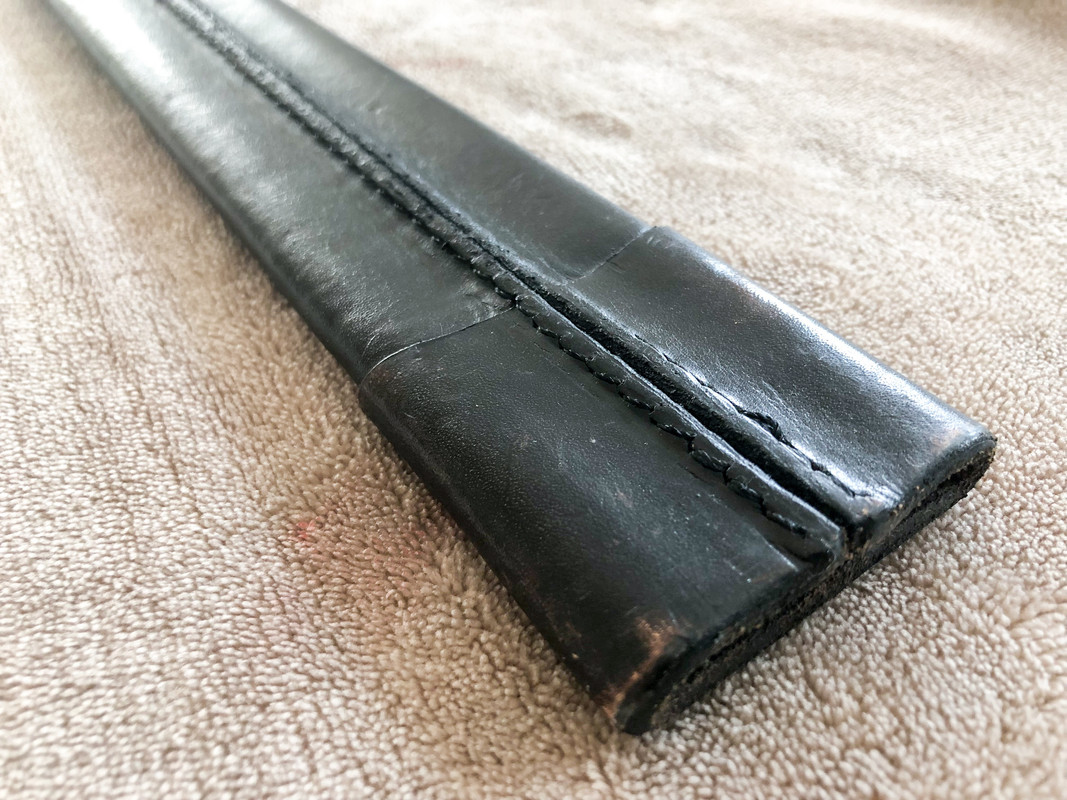
Handling Characteristics
Most definitely a thrust-oriented sword but has enough breadth to probably be decent at light cutting if it had a sharpened edge. Techniques like half-swording are easy peasy with this blade and the point likes to stay on target very well as you move through guards.
It’s a tad forward heavy to aid in this.
The kicker that makes this sword a pain to wield however, is the guard. The design is awful being an object of pure fantasy with little attention paid to practicality. Though one could imagine a guard punch would make for a bad day for the recipient... big time.
The ridges on the pommel (the cutouts on the grip side) can also bite into the palm too if swung in certain ways. All in all, not super comfortable sword to swing around without a glove on. 😑
The blade is balanced well, but not amazing. The distal taper is there but not so much to make this blade super “lively.” Certainly not a crowbar though like some swords I’ve wielded.
Test Cutting
No observations here, as I mentioned in the Full Disclosure section this sword is unsharpened.
But Oh How Many O’ Blackberry Bramble Hath Fallen in the back forty before this blade wielded by that young lad from many years ago... 🤣
If I ever sharpen this sword down the road, I will update this section of the review.
Conclusions
Definitely has a cool factor given the fantasy styling, the fact it is a long discontinued and somewhat rare model (I’ve literally NEVER seen or encountered another owner of one), and it has Unicorns which tickle the kid-like whimsy and nostalgia of that 12-year old boy who worked SO hard for this sword.
In the modern age, there are MUCH better options in the sword world.
I’d say only the die hard “oldies but goodies” type collectors after old discontinued swords that were in the original MRL catalogues would be interested in something like this.
Pros
Cons
The Bottom Line
For my very first sword purchase at age 12, almost 30 years ago before we had as many accessible options as we do now, I could have done far far worse. It’s a beautiful sword and will always have a special place in my heart, despite its shortcomings by today’s standards.
Sharpening the blade and replacing the guard would go a long way to making this sword more usable from a practical perspective, but to this day, I’ve never had the heart to do so (aside from sharpening, which I may yet do).
It all began on a spring day in 1991. A young lad, having spent years looking at his father’s saber and watching He-Man on Saturday mornings as well as movies like Ladyhawk, Krull, Legend, Labrynth, Conan, The Dark Crystal, Excalibur and many many other movies of the golden “sword and sorcerer” age of cinema as well playing The Legend of Zelda, Final Fantasy, Ninja Gaiden, Ghosts ‘n Goblins and all sorts of sword-related Nintendo games, decided he needed his own REAL sword.
Pleading and pleading to his mom and dad to no avail finally yielded a determination in this young lad: He would own a real sword.
Finally, the boy proposed a plan to his parents. What if he earned the money himself to buy one? Would they then let him get it? After much deliberation, the parents agreed as long as the sword was unsharpened (it was a 12-year old boy, after all).
The parents were dubious, however, that the boy would be able to earn that sheer amount of money to be able to purchase a sword, given the youngling’s propensity to chase shiny things at a whim at the time and had never before been able to muster hundreds of dollars toward any purchase.
But the boy was determined. Setting out to the neighbors pleading for any kind of work that would yield the precious coin to acquire a sword, he mowed lawns, raked yards, weeded gardens, hacked at brambles, picked berries and all sorts of other jobs until one day, towards the end of the summer of 1991, the boy had enough to consider a first sword purchase.
Now, what sword to acquire? Going to his stack of Museum Replicas and Atlanta Cutlery catalogues, the boy began pouring over the options that lay in front of him....
A scimitar? The “Sword of Chaos”? A simple and sturdy Norman sword? What blade would this young lad spend his dollars on?
Paging through the catalogues, his heart leapt when he came across a beautifully tapered and strongly pointed blade, with a blue suede wrapped handle with wire filigree and a rampant unicorn on the pommel.
His whimsy tickled and thinking immediately of one of his beloved films, “The Last Unicorn,” the boy’s decision had been made.
Lady Amalthea would be so proud.

Historical Overview
Going back nearly 30 years, in the days before the internet and social media, before we had SBG and the widespread options for sword purchasing was limited to few production companies and antique collection societies, MRL was in its golden age and reigned as one of the top outlets for purchasing swords. At the time their main vendors being offered were Del Tin, Windlass and in some cases Marto. (Windlass is still a clear favorite of theirs to this day).
This Del Tin model, under MRL’s fantasy section and called simply the “Unicorn Sword” was made from CK55 Krupp (remember that stuff? A particular 1055-type of blend by Krupp) steel and featuring a sort of narrow XV type blade.
While a work of fantasy, I believe the XV type of blade is the closest historical approximate category for this sword.
The Type XV sword saw its rise during the course of the second half of the 13th and into the 14th century when a blade that could find gaps in the rising plate armor was necessary. Swords started evolving away from the cutting-focused and wide blades and formed into finely pointed blades focused on thrusting with strongly reinforced diamond cross sections. Some width was kept for cutting and beginning the era of the thrust-oriented type blades that the XV represents.
The XV type of sword lasted for more than two centuries. More on the type XV can be read here and here.
Full Disclosure
Nothing aside from sentimentality over this being my very first sword I’ve ever owned will cloud my review.
I have no affiliation with Museum Replicas, Ltd. or Del Tin.
There is no cutting observations because, to this day, I’ve never sharpened this sword. I may do so at some point and will provide cutting observations at that point but currently do not have any cutting observations.
Final disclosure is that, to my knowledge, there is nowhere you can obtain one of these aside from a secondhand owner. This model has been discontinued for decades.
Initial Impressions
Well, now this was almost 30 years ago so there is little hope of giving my true and completely accurate first impressions, but I remember thinking how sturdy the sword felt. It was heavy (for a 12-year old), and the blade had more flex than I’d had expected. Now note, the ONLY sword I had ever held until this point was my father’s Prussian saber, whose blade is VERY stiff. So holding this new sword for the first time the blade flexing like it did surprised me. Now, many years later, I remark at actually how stiff this blade is compared to almost all of my other double-edged swords.
The suede was beautifully wrapped and the wire twist accents bright (now, the suede has worn down significantly and the wire has patina’d substantially but in its day this grip was STUNNING).
The guard was cool looking, but in retrospect is a TERRIBLE design, as I quickly learned when swinging it, the bottom points of the star-like protrusions on the ends jabbed me in the wrist. It’s not particularly comfortable. 😂
It swings... like a sword. By today’s standards it’s not amazing but it’s not a crowbar either. It’s a decent albeit-on-the-tip-heavy side of the sword’s type.
At the time in a 12-year old’s mind? I was in awe.
Statistics
- Blade Length: 32.87”
- Blade Width:
- At Guard: 1.62”
- 3” From the Tip: 0.9”
- Blade Thickness:
- At Guard: 5mm
- 3” From the Tip: 4mm
- Grip Length: 3.97”
- Overall Length: 39.75”
- Guard Width: 6.75”
- PoB (Point of Balance): 4.44” from the guard
- CoP (Center of Percussion): 21.37” from the guard
- Weight: 2lb. 13oz.
Components
Assembly / Construction
Construction is pretty consistent with production swords of this time period from MRL catalogue swords from the likes of Windlass and Del Tin. Keyed pommels were rarely if ever seen and peens were almost never to be found. I’m sure custom smiths did this 30 years ago, but the production companies that MRL were dealing with had not yet evolved to adopt these techniques very often, especially not for a sub-$300 sword.

The guard is relatively well-fit to the blade with no play when everything is tightened down. The hilt is attached via a threaded tang and thick rod that the guard, grip and pommel all slide into and are then tightened down with a hex nut (e.g. “threaded compression”).

Clearly not ideal by today’s standards given the stress it places on the grip.
See here for an explanation as to why pommel constructions matter.
Certainly not a rat-tail tang, however, and the shoulders are relatively wide (not quite ideally rounded) with plenty of meat on the tang. The rod appears to be welded on and threaded but the welds appear solid and sturdy, albeit not the cleanest.


I suspect if the grip were shortened by maybe a centimeter the pommel could be keyed on the shallower side and the protruding end of the tang out of the back could be peened. Minor modifications could make this a much more structurally sound sword. Even if not peened you could do a hex nut recess in the pommel and still make the sword able to be disassembled. But not without shortening the grip some and having an indexed and keyed pommel.
The Blade
The blade, essentially what I would consider a variant of the Type XV. Is predominantly a flattened diamond cross-section with a clearly visible central ridge that goes all the way to the point. The first 3/8ths of the blade has a flattened hexagonal cross section that fades into the flattened diamond, however, so that does deviate from the standard XV designation.
Brushed finished steel (roughly similar to which you’d see on Atrim type blades). It is relatively clean and crisp but there is a couple areas of surface grind ripple where the bevels are not completely a smooth plane.


This is better than the Windlass swords of the same era that I possess however.
I’m not sure whether Del Tin had hand forged blades at this time period or whether they were stock removal, but this blade has a hand forged “feel” to it, if that makes any sense.
Given the blade is unsharpened it has a 1/16th or so blunt edge (maybe 1-1.5mm?). The edge has a distinct, flat plane for the first 6” or so and is more “rounded” from there to the tip.

The blade has a nice even profile taper to the point which is not needle but more of a slightly rounded but very narrow point.

There is not much distal taper in the blade, literally a single millimeter over the entire length. This contributes greatly to the blade lacking a ton of liveliness and its somewhat tip-heavy feeling despite the sub-5” point of balance.
My biggest complaint about the blade itself though is the fact it has a super short ricasso where the base of the primary bevels terminate in a perpendicular direction to the edge like you’d see on a knife. I do NOT like this trait. I’d rather have seen the primary bevel taken all the way to the blade shoulders under the guard. If ever I got this sharpened, I’d seriously consider attempting to do this, but that would be a healthy amount of work.

The blade is very stiff but still has a nice spring temper. I have bent this blade 30-degrees or more without any issue with it returning to true.
Distinct and recognizable vibration node harmonic points along the blade when held and struck, all of which are appropriate for this type of blade.
The Grip
The grip, now worn with age, was STUNNING when the sword was new. A beautiful and radiant royal blue soft suede wrapped around hardwood, and then finished off with twisted wire filigree.
It’s been worn down with years of holding, handling, and swinging, but originally this grip was simply beautiful. The ergonomics of the grip are simple but comfortable, with the wire gaps sitting nicely in the fingers to give the grip a solid and grippy feel.



The Guard
Ok, this is where things get ugly. Where do I begin? First, the finish is not great. The lines are there but not super crisp. And the finish is kind of sloppy, probably just finished with a slack belt sander and no hand polishing.

The fit to the blade is remarkably well done however with there being very little if any play on the tang of the sword.
Now let’s get to the design... wow... just wow. Whoever thought this guard was a good idea on a sword was out of their minds. I look back, knowing what I do now, and want to smack that 12-year old kid upside the head for not choosing a different first sword.
The design is AWFUL from a practical use perspective. It jabs the wrist or forearm when maneuvering this sword. I literally cannot do any serious forms with this sword without a glove on because it just hurts and is uncomfortable.
Forget about doing a moulinette with this sword. It’ll chew your forearm up. Bad.
I suspect the whole “fantasy” notion here was you could use the guard as a nice weapon to punch out with, and that is for sure! Those points are sharp! Heck they have more of an edge than the blade does given it’s not sharpened 😂
But yeah. Out of all the downsides of the sword, this one is the BIGGEST issue. Ewww...
But it does look cool, right? 🙄
The Pommel
Yeah yeah. It’s not keyed, like I said in the construction section. Yeah yeah, it’s cast from mild steel. But c’mon! UNICORNS!!

How many swords do you see with unicorn motif? Unicorns are cool, people.
So to be honest this was probably the main reason I originally bought this sword. If you had read the introduction section you know why. I loved “The Last Unicorn” and this sword reminds me of it every single time I look at it.
Or... if you rather, for those fans of the Forgotten Realms setting of novels, I imagine this is a blessed sword of the goddess Mielikki whose main sigil is that of a unicorn. Side note: Mielikki was also an actual historical Finnish goddess.
Ok ok. Back to the review observations...
Practically speaking the pommel is on the heavy side to balance out the blade which has little distal taper, and the cutouts in the perimeter are also a bit uncomfortable to the wielder, also contributing to the discomfort when swinging this sword around. It is not as large of a contributing factor as the guard though.
Un-keyed with no fancy peen. It’s a simple pommel (aside from the cool unicorns, that is).

The Scabbard
Simple, black leather stitched scabbard. Not sure how MRL managed to milk people out of money on their early scabbards because these are really nothing special.
We have amazing scabbard makers out there that make wood core, leather wrapped scabbards so... way better ones out there. But let’s remember this was a sub-$300 sword and the scabbard option if I recall was $45. So... meh. It holds the blade.




Handling Characteristics
Most definitely a thrust-oriented sword but has enough breadth to probably be decent at light cutting if it had a sharpened edge. Techniques like half-swording are easy peasy with this blade and the point likes to stay on target very well as you move through guards.
It’s a tad forward heavy to aid in this.
The kicker that makes this sword a pain to wield however, is the guard. The design is awful being an object of pure fantasy with little attention paid to practicality. Though one could imagine a guard punch would make for a bad day for the recipient... big time.
The ridges on the pommel (the cutouts on the grip side) can also bite into the palm too if swung in certain ways. All in all, not super comfortable sword to swing around without a glove on. 😑
The blade is balanced well, but not amazing. The distal taper is there but not so much to make this blade super “lively.” Certainly not a crowbar though like some swords I’ve wielded.
Test Cutting
No observations here, as I mentioned in the Full Disclosure section this sword is unsharpened.
But Oh How Many O’ Blackberry Bramble Hath Fallen in the back forty before this blade wielded by that young lad from many years ago... 🤣
If I ever sharpen this sword down the road, I will update this section of the review.
Conclusions
Definitely has a cool factor given the fantasy styling, the fact it is a long discontinued and somewhat rare model (I’ve literally NEVER seen or encountered another owner of one), and it has Unicorns which tickle the kid-like whimsy and nostalgia of that 12-year old boy who worked SO hard for this sword.
In the modern age, there are MUCH better options in the sword world.
I’d say only the die hard “oldies but goodies” type collectors after old discontinued swords that were in the original MRL catalogues would be interested in something like this.
Pros
- Nicely tapered and stiff blade with strong thrusting capabilities for which the sword was designed
- Originally, the grip was absolutely beautiful
- Umm... hello? UNICORNS!
Cons
- The guard is really kind of terrible from a practical use perspective; it literally bites into the wrist for certain techniques.
- Not a fan of the edge bevel not continuing all the way into the guard.
- Nut-assembly with un-keyed pommel and what appears to be a welded thread rod on the bottom of the tang (although the weld appears solid)
The Bottom Line
For my very first sword purchase at age 12, almost 30 years ago before we had as many accessible options as we do now, I could have done far far worse. It’s a beautiful sword and will always have a special place in my heart, despite its shortcomings by today’s standards.
Sharpening the blade and replacing the guard would go a long way to making this sword more usable from a practical perspective, but to this day, I’ve never had the heart to do so (aside from sharpening, which I may yet do).


